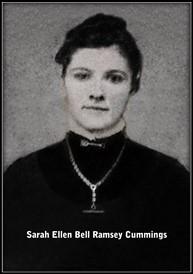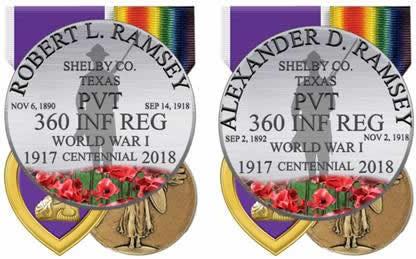 Robert Linzy and Alexader Dewitt Ramsey
Robert Linzy and Alexader Dewitt Ramsey
World War I Veterans
“Gold Star Brothers”
"Show me the manner in which a nation or a community cares for its dead and I will measure with mathematical exactness the tender sympathies of its people, their respect for the laws of the land and their loyalty to high ideals."…….William Gladstone
 September 14, 2017 - Brothers Robert Linzy “Bob” and Alexander Dewitt Ramsey were born in Shelby County, Texas 22 months apart in November 1890 and September 1892 respectively. Both were the sons of A. D. “Tinker” and Sarah Ellen Bell-Ramsey who were married on August 16, 1889 in Shelby County. Their father Tinker passed in March 1892 before the birth of Alexander leaving mother Sarah a widow with two very young sons. Five years later she would marry Jefferson Davis Cummings in October 1897 and step-siblings Sanford Brooks and Dudlye Bell Cummings would join the family. In 1910 the family had moved to a farm in Lafayette, Mississippi but the boys were both back in Texas working for the W. R. Pickering Lumber Company in Haslam when the first of three national registration days for the World War draft arrived on June 5, 1917. Both were single at that time but three days later Bob gained a sister-in-law when Alex married Miss Irene Brooks in Shelby County.
September 14, 2017 - Brothers Robert Linzy “Bob” and Alexander Dewitt Ramsey were born in Shelby County, Texas 22 months apart in November 1890 and September 1892 respectively. Both were the sons of A. D. “Tinker” and Sarah Ellen Bell-Ramsey who were married on August 16, 1889 in Shelby County. Their father Tinker passed in March 1892 before the birth of Alexander leaving mother Sarah a widow with two very young sons. Five years later she would marry Jefferson Davis Cummings in October 1897 and step-siblings Sanford Brooks and Dudlye Bell Cummings would join the family. In 1910 the family had moved to a farm in Lafayette, Mississippi but the boys were both back in Texas working for the W. R. Pickering Lumber Company in Haslam when the first of three national registration days for the World War draft arrived on June 5, 1917. Both were single at that time but three days later Bob gained a sister-in-law when Alex married Miss Irene Brooks in Shelby County.
Ten months later April 25, 1918 and one year after the United States entered the World War, both were inducted into the US Army taking the oath of enlistment in Haslam. The brothers packed up and headed to Camp Travis, Texas in San Antonio for basic training. Their stay there was short and three weeks later they were sent to Camp Mills, New York and placed in Company A, 360 Infantry Regiment of the 90th Infantry Division (later nicknamed “Tough Ombres”). Training continued in preparation for deployment to the war in France which happened on July 6, 1918. On that day the Ramsey brothers, both Privates boarded the British Liner RMS Olympic and departed New York Harbor for the 10-day voyage to Europe. As next-of-kin on the passenger list Bob listed his mother Sallie Cummings of Larcopala, Mississippi and Alex named his wife Irene of Haslam, Texas. Another Shelby County Soldier Private Dave T. Cannon of Choice was also listed as being on board.
Upon arrival training began and the 90th Division relieved the First Division on the night of August 21, 1918 and the Ramsey brothers as members of the 360th Regiment relieved some harden veterans of the 26th Regiment and for the first time took their turn under enemy fire. Until September 11 the Regiment remained in position guarding against a possible German attack. The plans called for the American Army to take the town of Saint-Mihiel that the Germans had occupied since 1914 and the French had been unable to retake. Known as the Battle of Saint-Mihiel, it was fought from September 12 – 15, 1918 under the command of General John J. (Blackjack) Pershing and was the first and only offensive launched solely by the United States Army in World War I. The German forces were caught retreating and the American Forces were more successful than had been expected.
During this four-day battle older brother Robert Ramsey was wounded in action on an unknown date but later died of those wounds on September 14, 1918. No record could be found how the family was notified but probably, it was by telegram and his brother Alex would have been told through military channels but again this is an educated guess.
The 360th Infantry moved on to participate in the Meuse-Argonne Offensive that lasted from September 26 to the armistice of November 11, 1918. This was the final Allied Offensive of World War I and the largest in United States military history involving 1.2 million American soldiers. This battle cost 28,000 German lives and 26,277 American lives making it the bloodiest operation of the World War for the American Expeditionary Force. On November 2, 1918 nine days before the armistice Alexander Ramsey like his brother died of wounds received in battle.
Mother Sarah Ellen who would live until 1943 lost two sons in the span of 49 days and had the two blue stars on her service banner turn to gold. But what of the remains? This was a question at the end of the war that had two sides. The military and General Pershing argued that burying servicemen at the battlefield with their fallen comrades offered the greatest glory. Even President Theodore Roosevelt whose son Quentin died when shot down over France demanded that his son be left where now buried.
Many Americans especially mothers demanded the government bring their dead sons home. Almost a year after the armistice in October 1919 the War Department came up with a plan that would ask each family what their desires were. They could bring their loved ones remains home or have them buried in new American military cemeteries in Europe. The mother of Bob and Alex Ramsey was part of the 30% who chose not to bring them home. For the past almost 99 years Robert Linzy Ramsey has rested with his fallen comrades in the Saint Mihiel American Cemetery in Lorraine, France and brother Alexander Dewitt Ramsey in the Meuse-Argonne American Cemetery also in Lorraine. Ironically this was the first time they had been apart since enlistment.
 During the 1920’s the Gold Star Mothers’ Association lobbied for a federally sponsored pilgrimage to Europe for mothers with sons buried overseas. The bond between wife and husband seemed almost secondary in the congressional debates and the bond between fathers and sons was barely considered as the association maintained that the maternal bond surpassed that of the paternal bond. In 1929 Congress enacted legislation that authorized the secretary of war to arrange for pilgrimages to the European cemeteries "by mothers and widows of members of military and naval forces of the United States who died in the service at any time between April 5, 1917, and July 1, 1921, and whose remains are now interred in such cemeteries." The federal government funded the entire pilgrimage providing transportation, food, lodging and medical care for the mothers and widows at a cost of over 53 million dollars. On February 7, 1930 First Lady Lou Henry Hoover drew lottery style one envelope of 48 that would determine which state would make the first trip to visit fallen sons. That state was Nebraska. Over the course of the program 6,654 women participated. These pilgrims represented the diversity of the American army in World War I. However, in keeping with the Jim Crow-Era segregation of the military at the time, the U.S. Army Quartermaster Corps racially segregated the pilgrimages. African-American women travelled in separate groups, a decision that created much controversy. While many objected, 168 African-American women still participated as pilgrims. According to the National Archives the Ramsey brother’s mother, Mrs. Sarah Cummings now living in Wichita Falls, Texas declined the offer.
During the 1920’s the Gold Star Mothers’ Association lobbied for a federally sponsored pilgrimage to Europe for mothers with sons buried overseas. The bond between wife and husband seemed almost secondary in the congressional debates and the bond between fathers and sons was barely considered as the association maintained that the maternal bond surpassed that of the paternal bond. In 1929 Congress enacted legislation that authorized the secretary of war to arrange for pilgrimages to the European cemeteries "by mothers and widows of members of military and naval forces of the United States who died in the service at any time between April 5, 1917, and July 1, 1921, and whose remains are now interred in such cemeteries." The federal government funded the entire pilgrimage providing transportation, food, lodging and medical care for the mothers and widows at a cost of over 53 million dollars. On February 7, 1930 First Lady Lou Henry Hoover drew lottery style one envelope of 48 that would determine which state would make the first trip to visit fallen sons. That state was Nebraska. Over the course of the program 6,654 women participated. These pilgrims represented the diversity of the American army in World War I. However, in keeping with the Jim Crow-Era segregation of the military at the time, the U.S. Army Quartermaster Corps racially segregated the pilgrimages. African-American women travelled in separate groups, a decision that created much controversy. While many objected, 168 African-American women still participated as pilgrims. According to the National Archives the Ramsey brother’s mother, Mrs. Sarah Cummings now living in Wichita Falls, Texas declined the offer.

(Sources: https://en.wikipedia.org/wiki/Battle_of_Saint-Mihiel/; https://en.wikipedia.org/wiki/Meuse-Argonne_Offensive; http://www.historynet.com/rest-in-peace-bringing-home-u-s-war-dead.htm; Family Search Feb & May 2017; Davis Dickey Jan 2010; Ancestry.com Apr & Sep 2017; book History of the 360th Infantry Regiment, Apr 15, 1919; Find A Grave Memorials 55966872 & 56341787; https://www.archives.gov/publications/prologue/1999/summer/gold-star-mothers-1.html; American Battle Monuments Commisision.gov Sep 2017).









